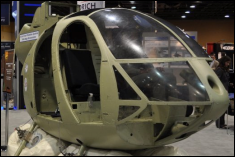 |

|
 |
Active Crash Protection System Technology Demonstrator on Display at the 66th Annual Forum of the American Helicopter Society (May, 2010) in Phoenix, AZ |
|
The Boeing-led Rotorcraft Active Crash Protection System Development Team, consisting of Boeing, the U.S. Army Aviation Applied Technology Directorate (AATD), Honeywell, General Dynamics Ordnance and Tactical Systems, and the Smart Structures Laboratory of the Alfred Gessow Rotorcraft Center at the University of Maryland., were awarded the 2011 Harry T. Jensen Award by the American Helicopter Society for an outstanding contribution to the improvement of vertical flight aircraft reliability, maintainability, and/or safety through improved design brought to fruition during the preceding year. During 2010, the Boeing-led Rotorcraft Active Crash Protection System Development Team was successful in bringing a new set of technologies to Military Rotorcraft through a series of experiments and demonstrations. These new technologies greatly increase the effectiveness of rotorcraft crash protection systems and significantly improve rotorcraft crash survivability.
The effectiveness of crash protection systems can be significantly increased by utilizing an integrated Active Crash Protection System that can sense an impending crash or hard landing event and then actively control the response of the crash protection subsystems to provide the optimum level of aircrew crash protection for the anticipated impact conditions. The ACPS team developed a prototype Active Crash Protection System (ACPS) under contract to U.S. Army Aviation Applied Technology Directorate (AATD) to improve crash survivability of rotorcraft aircrew. The ACPS is an integrated system that includes sensors, electronic control unit, and software algorithms that can predict an impending crash event and activate and control the appropriate crash protection subsystems including active internal and external airbags, landing gears, seats, and restraint systems.
The performance of the prototype ACPS and integration of its subsystems were demonstrated by virtual and physical mockups, hardware-in-the-loop simulations using the Apache flight simulator, prototype hardware fabrication, and testing, including a full-scale aircraft drop test. The prototype ACPS developed has an open architecture to integrate active crash protection system from multiple suppliers to provide best-of-industry technology solutions. The analysis and test results have demonstrated that the prototype ACPS system will provide the optimal level of aircrew protection for current and future rotorcraft while also minimizing aircraft and mission equipment (MEP) damage in a variety of crash impact conditions. Honeywell provided the multi-processor unit to execute the crash sensing and control algorithms onboard the aircraft. General Dynamics Ordnance and Tactical Systems provided the airbag and gas generator technology to develop the external airbag crash protection subsystem.
The University of Maryland provided expertise in magnetorhelogical (MR) energy absorbers to develop the active landing gears. Prof. Norman M. Wereley, and his team of Dr. Young-Tao Choi, Dr. Wei Hu and Ryan Robinson (current MS student), developed a full scale landing gear oleo, and characterized its performance under drop tests for both open-loop (uncontrolled) and closed-loop control situations. Prof. Wereley stated that ?the demonstrated success of the Boeing ACPS Team is a key case study that demonstrates why the helicopter community needs strong collaborations between industry, government, and academia. Development of the Boeing ACPS will surely provide critically needed capabilities, in both existing and future rotorcraft, that have the potential to greatly decrease the potential for injuries from crash impacts.?
This project was funded by the Aviation Applied Technology Directorate under Aircrew Survivability Technologies Army Technology Objective AST-ATO Cycle I and II Programs. The Boeing-led ACPS Team represents the excellent collaboration between Industry, Government, and Academia in developing a much needed ACPS technology solution to improve the crash survivability of rotorcraft.

Magnetorheological Landing Gear Oleo Being Drop Tested in the Vertical Axis Vibration and Shock Stand in the Smart Structures Laboratory at UMD.
Related Articles:
Taking Flight
UMD and GA Tech Capture Top Honor in the 28th Annual AHS/Industry Student Design Competition
AGRC is a Vertical Lift Research Center of Excellence
Awais Raza Receives Golden Key Boeing Scholarship
March 29, 2011
|

